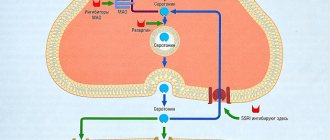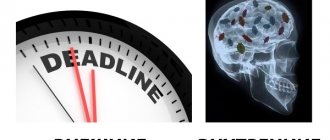The modern “crazy” rhythm of life, the endless flow of information that a person needs to process daily, as well as many other, mostly negative factors, lead to the fact that the body and psyche cannot stand it. Insomnia and stress, impaired performance and communication, often ignored and most often suppressed by medications or other potent substances, ultimately lead to such complex diseases as chronic fatigue syndrome (CFS) and various depressions. According to the forecasts of medical analysts, by the 20s of this century depression will outstrip the leaders of the 20th century - infectious diseases and diseases of the cardiovascular system - in the number of cases of illness. In the fight against depressive disorders, various drugs based on both natural and synthetic components are used.
Antidepressants - what are they? What are they and can these medications cure depression or only alleviate its symptoms? What are the advantages and disadvantages of such drugs? In this article we will try to answer these and other questions about antidepressants, the effect of their use and the consequences of taking them.
A little history
Before we begin to consider modern groups and types of antidepressants, we will briefly talk about the history of their discovery.
Until the mid-twentieth century, depression and various neurotic conditions with similar symptoms were treated with a variety of herbal preparations. To “lift the mood,” various stimulant compounds were used, which included caffeine, ginseng, or opiates. They tried to “calm down” the nervous excitement with bromine salts or medications based on valerian officinalis. Various types of gymnastics and physiotherapeutic procedures were also used, the effectiveness of which was rather insignificant.
In the early 50s of the twentieth century, the drug “Promethazine” was created, initially used for anesthesia during surgical operations. Pharmacologists tried to enhance the inhibitory and suppressive effect of this medication, as a result of which, by 1951, Chlorpromazine was obtained, which became widely used in medical practice for the treatment of depression. Today this drug is known as Aminazine.
At the end of the 60s of the last century, Swiss doctors treating patients with tuberculosis noted a rather unusual side effect of a drug such as Iproniazid. Patients who received it were characterized by elevated mood. Gradually they began to use it in psychiatric practice, since it helped very little against tuberculosis. Around the same time, German researcher Ronald Kuhn discovered the drug Imipramine.
The discovery of the first thymoleptics led to the rapid development of pharmacological research in this area and the creation of new medications aimed at combating the symptoms and causes of depressive disorders.
Modern classification
Depending on the effect the use of antidepressants has on a depressed patient, they are divided as follows:
| Group | Main action | Drugs |
| Sedatives | Relieving psycho-emotional stress without a hypnotic effect | "Gerfonal", "Amitriptyline" |
| Balanced action | They can only be taken as directed and under the supervision of a physician, since when taking large doses a stimulating effect occurs, but medium doses have a calming effect | "Lyudiomil" "Pyrazidol" "Azafen" |
| Stimulating | Used in the treatment of depressive conditions with symptoms of lethargy and apathy | "Aurorix" "Melipramine" "Anafranil" "Befol" |
In addition, there is a classification based on how the action of antidepressants affects the course of biochemical processes in the human body:
- TCAs are tricyclic thymoanaleptics.
- MAOIs – monoamine oxidase inhibitors:
- irreversible (“Tranylcypromine”, “Phenelzine”);
- reversible (“Pyrazidol”, “Moclobemide”).
- SSIs – selective serotonin uptake inhibitors;
- IOSSIN - serotonin and norepinephrine reuptake inhibitors;
- NaSSA are noradrenergic and specific serotonergic antidepressants.
There are also a number of antidepressant drugs that cannot be classified into any of these groups.
TCAs: tricyclic antidepressants, what are they?
Tricyclic drugs such as Nortriptyline, Imipramine and Amyltriptyline get their name from the underlying triple carbon ring. These antidepressant drugs help increase the amount of neurotransmitters in the brain such as norepinephrine (norepinephrine) and serotonin (the happy hormone). This is achieved by reducing the level of their consumption by nerve cells - neurons.
Because these medications block more than just essential neurotransmitters, many different side effects occur. Taking tricyclic antidepressants can cause the following side effects:
- lethargy;
- drowsiness;
- nausea;
- dry mouth;
- weakness;
- dizziness;
- increased heart rate - pulse;
- constipation;
- decreased potency and libido;
- worry or anxiety.
Such medications, as a rule, are prescribed by doctors first, since they are the most studied and the consequences of their use are well known.
Side effects
SSRI drugs are much better tolerated, and the anticholinergic side effects that are inherent in tricyclic antidepressants are less pronounced. They are safer and suitable for patients with cardiac arrhythmias and closed-angle glaucoma. Even with an overdose, a pronounced cardiotoxic effect is not observed, as is the case with tricyclics.
Note. To reduce the likelihood of side effects, you must adhere to the treatment regimen prescribed by your doctor.
Side effects of SSRI drugs are caused by the fact that serotonin receptors are found not only in the central nervous system, but also in the muscle tissue of the gastrointestinal tract, bronchi and vascular walls. As a result, the following negative consequences are possible:
- nausea, vomiting;
- abdominal pain;
- bowel dysfunction;
- headache, dizziness;
- blurred vision;
- insomnia or drowsiness;
- lack of coordination;
- tachycardia;
- convulsions;
- hyperactivity, central nervous system stimulation;
- manic states;
- increased anxiety;
- sexual disorders (erection problems, delayed ejaculation, frigidity in women);
- leukopenia, thrombocytopenia;
- allergic reactions.
With long-term treatment, gastrointestinal bleeding and intracranial hemorrhage are possible.
A rare but life-threatening side effect is serotonin syndrome. It occurs when SSRIs are combined with MAO inhibitors or other antidepressants.
When treating with non-selective monoamine oxidase inhibitors, you need to take a 2-week break.
MAOIs – monoamine oxidase inhibitors
The drug "Iproniazid", which was one of the first to be discovered, as well as other medications in this group, such as "Isocarboxazid", "Tranylcypromine", suppress the enzymatic reaction of monoamine oxidase contained in the nerve endings. Thanks to this, neurotransmitters responsible for our mood, such as serotonin, tyramine and norepinephrine, are not destroyed, but gradually accumulate in the brain.
Most often, MAOI antidepressants are prescribed for atypical depression or when tricyclic medications are not suitable and do not have the desired effect. The advantage of medications in this group is that they do not have a suppressive effect, but, on the contrary, stimulate mental processes.
Just like tricyclics, MAOIs do not have an immediate effect on a person’s condition - the effect of antidepressants begins several weeks after starting to take them.
Due to the fact that MAO inhibitors have many side effects (and also easily interact with cough and cold medications and can provoke a life-threatening increase in blood pressure), and also due to a rather strict diet when taking them Such drugs are prescribed quite rarely, when other treatment methods have not helped.
Pharmacokinetics
When taken orally, it is well absorbed from the gastrointestinal tract (up to 95% of the dose taken), administration with food slightly inhibits the absorption of fluoxetine.
The “first pass” effect through the liver is weakly expressed. Cmax in blood plasma is reached after 6–8 hours. The bioavailability of fluoxetine after oral administration is more than 60%. The drug accumulates well in tissues and easily penetrates the BBB. Binding to blood plasma proteins is more than 90%. In the liver, enantiomers are demethylated with the participation of the CYP2D6 isoenzyme of cytochrome P450 to norfluoxetine and other unidentified metabolites, and S-norfluoxetine is equal in activity to R- and S-fluoxetine and superior to R-norfluoxetine.
Excreted by the kidneys, the clearance of fluoxetine is 94–704 ml/min, norfluoxetine is 60–336 ml/min. Renal failure does not have a significant effect on the rate of elimination of fluoxetine. About 12% of the drug is excreted through the gastrointestinal tract. The half-life (T1/2) of fluoxetine is 1–3 days after a single dose and 4–6 days with long-term administration.
unchanged - 11.6%, in the form of fluoxetine glucuronide - 7.4%, norfluoxetine - 6.8%, norfluoxetine glucuronide - 8.2%, more than 20% - hippuric acid, 46% - other compounds; 15% is excreted by the intestines. If renal function is impaired, the elimination of fluoxetine and its metabolites slows down. It is not excreted during hemodialysis (due to the large volume of distribution and high degree of binding to plasma proteins). The drug is excreted in breast milk (up to 25% of the serum concentration).
When taken orally, it is well absorbed from the gastrointestinal tract (up to 95% of the dose taken), administration with food slightly inhibits the absorption of fluoxetine. The “first pass” effect through the liver is weakly expressed. Cmax in blood plasma is achieved after 6-8 hours. The bioavailability of fluoxetine after oral administration is more than 60%.
The drug accumulates well in tissues and easily penetrates the BBB. Binding to blood plasma proteins is more than 90%. In the liver, enantiomers are demethylated with the participation of the cytochrome P450 isoenzyme CYP2D6 to norfluoxetine and other unidentified metabolites, and S-norfluoxetine is equal in activity to R- and S-fluoxetine and superior to R-norfluoxetine.
Excreted by the kidneys, the clearance of fluoxetine is 94-704 ml/min, norfluoxetine is 60-336 ml/min. Renal failure does not have a significant effect on the rate of elimination of fluoxetine. About 12% of the drug is excreted through the gastrointestinal tract. The half-life (T1/2) of fluoxetine is 1-3 days after a single dose and 4-6 days with long-term administration.
unchanged - 11.6%, in the form of fluoxetine glucuronide - 7.4%, norfluoxetine - 6.8%, norfluoxetine glucuronide - 8.2%, more than 20% - hippuric acid, 46% - other compounds; 15% is excreted by the intestines. If renal function is impaired, the elimination of fluoxetine and its metabolites slows down. It is not excreted during hemodialysis (due to the large volume of distribution and high degree of binding to plasma proteins). The drug is excreted in breast milk (up to 25% of the serum concentration).
The pharmacokinetics of fluoxetine explain the fact that its side effects may persist for a longer time than other SSRIs; the risk of developing serotonin syndrome due to drug interactions is also higher. Since the pharmacokinetics of fluoxetine is nonlinear, increasing its dose leads to a disproportionate increase in the level of the drug in the blood[6], accordingly to a disproportionately pronounced clinical effect and the same disproportionately pronounced side effects[7].
Selective serotonin uptake inhibitors
The groups of TCAs and MAOIs we considered are, for the most part, long-discovered and well-studied drugs. But the “old” generations of antidepressants are gradually being replaced by more modern drugs, the action of which does not block all mediators, but only one - serotonin, preventing its re-uptake by neurons. Thanks to this, its concentration increases and a therapeutic effect occurs. IIPS include such modern drugs as Fluoxetine, Sertraline, Zoloft, Paroxetine and others. Medicines in this group have fewer side effects, and they do not have such a strong effect on the human body.
Comparison of ease of use of Zoloft and Fluoxetine
This includes dose selection taking into account various conditions and frequency of doses. At the same time, it is important not to forget about the release form of the drug; it is also important to take it into account when making an assessment.
The ease of use of Zoloft is approximately the same as that of Fluoxetine. However, they are not convenient enough to use.
The drug ratings were compiled by experienced pharmacists who studied international research. The report is generated automatically.
Last update date: 2019-09-19 05:59:54
Serotonin and norepinephrine reuptake inhibitors
These are fairly new drugs that are already considered to be the third generation of antidepressants. They began to be produced in the mid-90s of the twentieth century.
Drugs such as Cymbalta and Effexor block the reuptake of not only serotonin, but also noripinephrine, while drugs such as Wellbutrin and Zyban prevent the reuptake of norepinephrine and dopamine.
The side effects of medications in this group are much less than those of others, and they are rather mild. After taking antidepressants based on inhibitors such as Duloxetine and Bupropion, weight gain and slight dysfunction in the sexual sphere may be observed.
Comparison of the effectiveness of Zoloft and Fluoxetine
The effectiveness of Zoloft is quite similar to Fluoxetine - this means that the ability of the drug substance to provide the maximum possible effect is similar.
For example, if the therapeutic effect of Zoloft is more pronounced, then using Fluoxetine even in large doses will not achieve this effect.
Also, the speed of therapy - an indicator of the speed of therapeutic action - is approximately the same for Zoloft and Fluoxetine. And bioavailability, that is, the amount of a drug reaching its site of action in the body, is similar. The higher the bioavailability, the less it will be lost during absorption and use by the body.
Noradrenergic and specific serotonergic antidepressants - NaSSA
Another modern group of antidepressant drugs is NaSSA, which slow down or completely stop the uptake of norepinephrine at the synapses of nerve cells, thereby increasing its concentration. Medicines such as Remeron, Lerivon, Serzon block serotonin receptors.
When taking medications in this group, mild unpleasant side effects such as drowsiness, dry mouth, increased appetite and associated weight gain are observed. Cancellation of antidepressants from this group proceeds without any serious problems.
In addition to the main groups of antidepressants presented above, there are a number of drugs that cannot be classified as one of them. They differ in both chemical composition and mechanism of action. These are, for example, drugs such as Bupropion, Hypericin, Tianeptine, Nefazodone and many others.
Alternative Methods
Today, foreign specialists are increasingly using drugs to treat depressive conditions that act not on neuromediators and neurotransmitters, but on the state of such organs of the endocrine system as the adrenal glands, hypothalamus and pituitary gland. Some of these drugs, for example, Aminoglutethimide and Ketoconazole, block the synthesis of the hormone cortisol by the adrenal glands, but they have many side effects and have a negative impact on the endocrine system.
The second group usually includes antalarmin receptor antagonists, which combine the positive qualities of tranquilizers and antidepressants.
In addition to drug treatment of depressive conditions, methods such as periodic normobaric hypoxia and plasmapheresis, light therapy, and many others are increasingly being used to help reduce manifestations and alleviate symptoms.
Pros and cons
Most people who have taken antidepressants agree that they are very effective medications, especially if they are taken at the same time as a specialist course of therapy. It should be remembered that these drugs, as well as their dosage, can only be prescribed by a doctor, under whose supervision they should be taken. Don't expect immediate improvement. As a rule, a feeling of hopelessness and loss of interest in life, as well as lethargy, apathy and sadness disappear within 3-4 weeks after the start of systematic use.
One of the biggest disadvantages of these medications is antidepressant withdrawal syndrome, which occurs when you stop taking them abruptly and uncontrollably.
Why are people looking for fluoxetine analogs?
Fluoxetine is a popular and well-established drug that people have been purchasing for many years. But today, more and more often, patients are looking for substitute analogues of this remedy. This is due to the following reasons.
Price issue
Fluoxetine is not the cheapest drug (its price is about 300 rubles) and in order to save money you have to look for more affordable analogues.
Among them are Framex and Flunat - these are more affordable medications that cost from 100 to 150 rubles, and their low price is due to their less famous name.
By-effect
Fluoxetine is a high-quality and proven drug, but it has certain disadvantages, or rather a number of side effects:
- bowel dysfunction;
- infrequent headaches that appear an hour after administration;
- increased heart rate, which can lead to tachycardia;
- overdrying of the mucous membrane;
- blurred vision;
- increased sweat secretions;
- general malaise;
- Women who took the drug experienced pain in the mammary glands and menstrual irregularities (up to several weeks);
- nausea and vomiting;
- noise in ears;
- constant feeling of fatigue;
- sleep disorders;
- depression;
- acne and allergic irritations;
- broken bones;
- sexual apathy (loss of interest in sex).
The list of contraindications is quite long and that is why most people are looking for more harmless analogues. For example, it could be Flunat or Deprex. The drugs have a natural composition and a less aggressive effect on the patient’s body.
No choice
Of course, the last reason why people turn to analogues of this drug is simply its absence on the shelves in pharmacies, since Fluoxetine is a sought-after medication.
If this medicine is not available in the pharmacy, then you should turn your attention to Profluzac and Fluval, which are identical in their action and composition.
How to apply it correctly?
1. If you have been diagnosed with heart, kidney or liver disease, be sure to tell your doctor.
2. Antidepressants act individually, so a specialist will select a drug that is suitable specifically for you.
3. In some cases, one medicine is not enough; the doctor may prescribe several at the same time (tranquilizers and antidepressants, antipsychotics and any anticonvulsants). Based on the diagnosis and monitoring your physical condition, the specialist will select drugs that can complement each other and will not have a negative effect on the human body.
4. You should not stop taking antidepressant medications suddenly and without consulting a specialist, as this can aggravate the course of depression and cause various unpleasant physiological reactions.
5. Many people ask whether it is possible to drink antidepressants and alcohol together. All instructions for medications indicate that this is strictly unacceptable, as it can lead to serious damage to the nervous system, including death.
Withdrawal syndrome or addiction?
If you have been taking antidepressants for a long time and then abruptly stopped for some reason, you may experience unpleasant sensations such as emotionally unstable behavior, increased fatigue, muscle pain, and dizziness. All of these symptoms are known as antidepressant withdrawal syndrome.
That is why doctors recommend gradually reducing the dose of medication taken and doing this under the supervision of specialists. Only professionals will help relieve discomfort by selecting the necessary normotonics and plant-based preparations. If the drug was taken uncontrolled, and then its use was abruptly stopped, such withdrawal of antidepressants can lead to sleep disturbances, increased anxiety, and problems with the cardiovascular system. In addition, the following symptoms may occur:
- unreasonable fears;
- flu-like symptoms;
- nausea, vomiting;
- spasms and pain in the gastrointestinal tract;
- loss of coordination and dizziness;
- nightmares;
- tremor of the limbs.
special instructions
Use fluoxetine with caution in patients with acute cardiovascular disease[11].
When treating patients with underweight, anorexigenic effects should be taken into account (progressive weight loss is possible). In patients with diabetes mellitus, the administration of fluoxetine increases the risk of hypoglycemia, and when it is discontinued, hyperglycemia may occur[23]. In this regard, the dose of insulin and/or any other hypoglycemic drugs used orally should be adjusted.
Until significant improvement in treatment occurs, patients should be under medical supervision.
During treatment with fluoxetine, you should refrain from drinking alcohol. Fluoxetine is prescribed with caution for activities that require a high concentration of attention and speed of reactions [12].
In old age, treatment with fluoxetine should begin with 1/2 dose.
When treating patients with underweight, anorexigenic effects should be taken into account (progressive weight loss is possible). In patients with diabetes mellitus, the use of fluoxetine increases the risk of developing hypoglycemia and hyperglycemia when it is discontinued. In this regard, the dose of insulin and/or any other hypoglycemic drugs used orally should be adjusted.
Until significant improvement in treatment occurs, patients should be under medical supervision. During treatment, you should refrain from drinking alcohol and engaging in potentially hazardous activities that require increased attention and speed of mental and motor reactions. The interval between the end of therapy with MAO inhibitors and the start of treatment with fluoxetine should be at least 14 days;
- When using drugs against the background of electroconvulsive therapy, the development of epileptic seizures is possible.
- Can be prescribed no earlier than 2 weeks after discontinuation of MAO inhibitors. After discontinuation of the drug, at least 5 weeks must pass before starting treatment with MAO inhibitors.
- During treatment, you should refrain from drinking alcohol and engaging in potentially hazardous activities.












